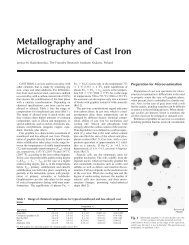Introduction Quantitative X-Ray Diffraction Methods Introduction ...
Introduction Quantitative X-Ray Diffraction Methods Introduction ...
Introduction Quantitative X-Ray Diffraction Methods Introduction ...
Create successful ePaper yourself
Turn your PDF publications into a flip-book with our unique Google optimized e-Paper software.
<strong>Introduction</strong> <strong>Quantitative</strong> X-<strong>Ray</strong> <strong>Diffraction</strong> <strong>Methods</strong><br />
(prepared by James R. Connolly, for EPS400-001, <strong>Introduction</strong> to X-<strong>Ray</strong> Powder <strong>Diffraction</strong>, Spring 2010)<br />
peak intensities reflect the total scattering from the each plane in the phase’s crystal structure,<br />
and are directly dependent on the distribution of particular atoms in the structure. Thus<br />
intensities are ultimately related to both the structure and composition of the phase.<br />
The diffraction intensity equation has been described previously, and is summarized below.<br />
I<br />
where:<br />
( hkl)<br />
I<br />
0<br />
64<br />
3<br />
r<br />
2<br />
e<br />
m c<br />
e<br />
2<br />
2<br />
M<br />
V<br />
( hkl)<br />
2<br />
F<br />
( hkl)<br />
I<br />
(hkl)<br />
= Intensity of reflection of hkl in phase .<br />
I<br />
0<br />
= incident beam intensity<br />
r = distance from specimen to detector<br />
= X-ray wavelength<br />
2 2 2<br />
( e / mc ) = square of classical electron radius<br />
2<br />
1<br />
cos<br />
2<br />
sin<br />
(2<br />
2<br />
)cos<br />
s = linear absorption coefficient of the specimen<br />
v = volume fraction of phase<br />
M hkl = multiplicity of reflection hkl of phase<br />
0 = Lorentz-polarization (and monochromator) correction (next to last term to right)<br />
v = volume of the unit cell of phase<br />
2 m = diffraction angle of the monochromator<br />
F (hkl) = structure factor for reflection hkl of phase (i.e., the vector sum of scattering<br />
intensities of all atoms contributing to that reflection).<br />
Recognizing that many of these terms are consistent for a particular experimental setup we<br />
can define an experimental constant, K e . For a given phase we define another constant,<br />
K (hkl) , that is effectively equal to the structure factor term for phase . Substituting the<br />
weight fraction (X ) for the volume fraction, the density of the phase ( ) for the volume, and<br />
the mass absorption coefficient of the specimen ( / ) s for the linear absorption coefficient<br />
yields the following equation:<br />
I<br />
( hkl)<br />
( hkl)<br />
cos<br />
This equation describes in simpler terms the intensity for peak hkl in phase .<br />
K<br />
e<br />
The fundamental problem (aside from the non-trivial problem of getting accurate intensity<br />
measurements from a homogeneous randomly oriented powder) lies in the mass absorption<br />
coefficient for the sample, ( / ) s . If this quantity is known, the calculations are simple. The<br />
problem is that in most experiment ( / ) s is a function of the amounts of the constituent<br />
phases and that is the object of our experiment. Basically, all of the peak intensity-related<br />
methods for doing quantitative analysis discussed subsequently involve circumventing this<br />
problem to make this equation solvable.<br />
K<br />
(<br />
/<br />
X<br />
)<br />
s<br />
2<br />
(2<br />
m<br />
)<br />
hkl<br />
v<br />
s<br />
(Material in this document is borrowed from many sources; all original material is ©2010 by James R. Connolly)<br />
(Revision date: 6-Apr-10) Page 2 of 14








